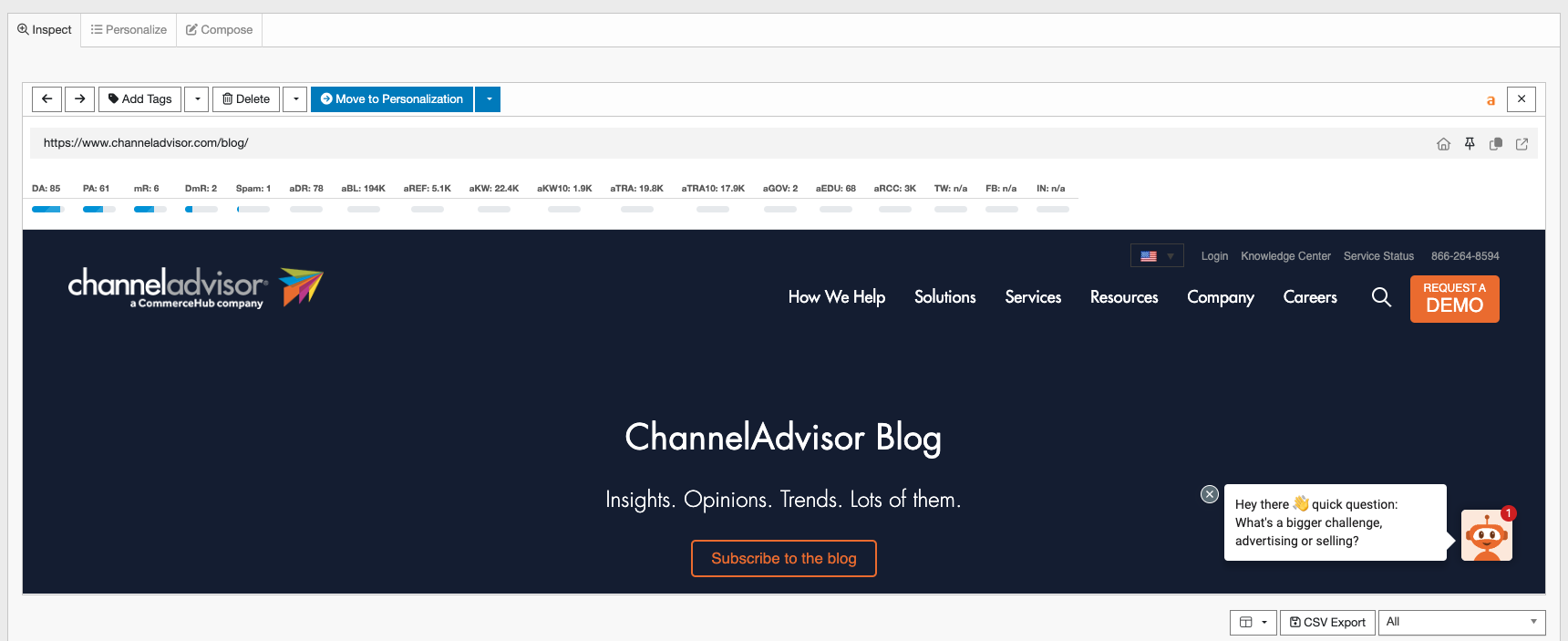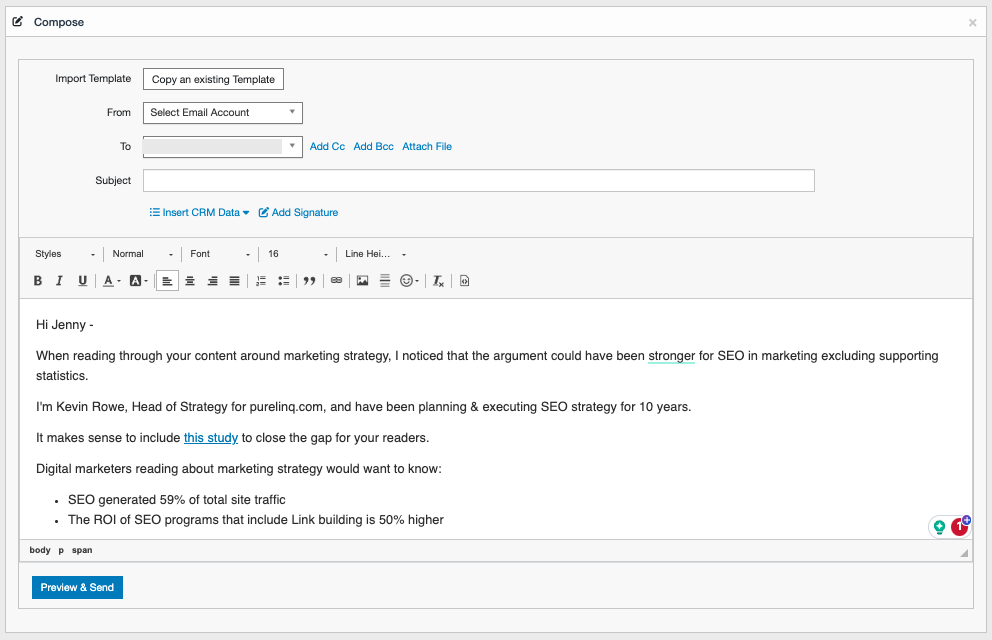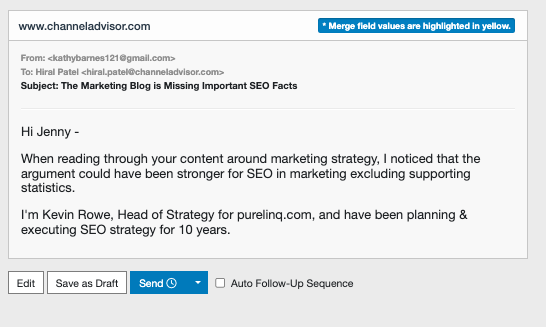At first, link building may not come easy, but you will build trusted links as you refine your approach.
One of the fundamental skills of link building is email outreach and email message design. Many consider outreach for link building a volume game, but when done the right way, it can help you build impactful links from reputable websites and creators.
I created this guide to ensure someone new to link building has early and long-term success, maximizing responses from outreach to reputable blogs and influencers.
Below we’ll explore how to be helpful to creators, building backlinks or brand mentions as a result.
To this end, the guide contains a non-spammy approach to outreach, tips to get responses from email, an email builder spreadsheet template, and details on running campaigns with link building tools.
This approach offers a different perspective on link building outreach and requires a very different definition from common understandings.
What Is Link Building Outreach?
Link building outreach is a strategic phase in the link building process where individuals or organizations actively initiate contact with other websites, bloggers, influencers, or content creators.
The primary objective is to cultivate an authentic reputation by fostering collaboration, enhancing brand visibility, or disseminating valuable content.
A successful outreach campaign will naturally result in both inferred (e.g., brand or content mentions) and direct backlinks, with an emphasis on building meaningful connections and enhancing the site and content creator’s reputation.
While email remains the most commonly used medium for outreach, advanced link building strategies may incorporate social media engagement, phone calls, or even direct mail to establish rapport and facilitate mutually beneficial partnerships.
How To Approach Outreach The Right Way
Approach each email pitch as if it were coming from an expert contributor, passionate about creating helpful content or resources around their topic areas.
A creator’s biggest concern is creating content that is valuable to the reader, so they read, engage, and return.
When planning content for niche readers, would you rather be sold an idea? Or would you rather collaborate with experienced, expert peers to create high-value content for the readers?
In this scenario, you’re at an event with a group of peers talking about SEO. The group all have personal experiences trying to rank commercial pages, but failing. One peer explains how he figured figured out how to rank those pages, with internal linking. The peer has the solution to your problems. But then a non-SEO interjects to say, “Can’t you just buy a few links to the page,” without understanding the group has a philosophy.
This is what a trusted content creator feels like when they receive a templated email pitch.
An expert has to use the email to show proof that they are an expert, through experience and insights. Show your proof by:
- Researching the creator: Read or listen to their content around a topic.
- Understanding them: Understand their perspective and knowledge gaps, and use that to craft the email.
- Establishing a reputation: Show how authoritative sources trust your content, people, or the company behind it.
When crafting an email, use your experience to be helpful to the readers.
How To Craft An Email So It Gets Opened And Read
Just prove that you read, understand, and can improve the prospective site’s content around a topic.
As long as the content gaps identified are substantial, the email becomes about showing your passion and understanding of the topic.
Below are the primary email fields and examples that an outreach specialist could write. Ensure each field mentions the gaps or how to improve the content.
The Anatomy Of A Helpful Email
Subject: A subject line is a short introduction to the preheader or email body.
The Marketing Blog is Missing Important Facts
Preheader: A preheader shows on some email clients and mobile email apps.
I found a faily large gap in your marketing strategy content around SEO specifically.
Helpful Body: This is the primary copy of the email.
Hi Jenny –
When reading through your content around marketing strategy, I noticed that the argument could have been stronger for SEO in marketing excluding supporting statistics.
I’m Kevin Rowe, Head of Strategy for Example.com, and have been planning & executing SEO strategy for 10 years.
It makes sense to include <a href=”https://example.com/seo-statistics”>this study</A> to close the gap for your readers.
Digital marketers reading about marketing strategy would want to know:
– SEO generated 59% of total site traffic
– The ROI of SEO programs that include Link building is 50% higherBy adding additional details about SEO, you can make your content much more helpful for digital marketers.
Please let me know if you’re interested or think a custom piece can make it a better fit, and happy to create a new article around this topic.
cheers,
Expert Signature: At the bottom of an email is the signature, and this is drastically underutilized. Include items that can enhance your reputation or trust.
Kevin Rowe
Founder & Head of Strategy
PureLinq
Publications:
Fast Company, Forbes, Search Engine Journal
Sample clients:
Coca-Cola, Siemens, The Hartford, Hyatt Hotels, Vmware
Speaking:
Search Engine Journal webinar series
Pro Tips
- Avoid generic and overused templates, and customize to the topic.
- Explain the content findings of the content analysis.
- Identify how you will fill any topical gaps.
- Demonstrate experience, expertise, authority, and trust.
How To Get A Response To Your Outreach Email
The success of link building outreach hinges on three key factors: relevant content pitches, you have expertise, and that person understands and needs your content.
Be relevant: Select topics based on current relevance with trending topics or the maturity of the news cycle.
Demonstrate expertise or experience: Succinctly show, don’t tell, how your experience is valuable and has provided you with unique insight.
The right message to the right person: If an email is overly technical, but you are dealing with an editor with a broad knowledge base, then the reader might get confused and move on to a more straightforward email to understand.
Common contact types include:
- Expert creator: Blogger with experience and expert-level knowledge of the subject.
- Editor: Highlight polished, high-quality content.
- Writer/Contributor: Offer unique perspectives or content gaps.
- Webmaster: Be direct, focusing on technical aspects.
- Marketing Team: Emphasize potential traffic or engagement benefits.
But if that email doesn’t get a reply, a friendly follow-up might be the right solution.
How And When To Follow Up Your Email
A follow-up email needs to account for why the contact didn’t reply and focus on nurturing a relationship.
Link building outreach often faces challenges, from trust issues to timing mismatches. Recognizing these challenges and addressing them systematically can significantly improve your response rate.
Here’s a breakdown of common obstacles and a sequence to overcome them:
Common Obstacles:
- Trust: “They don’t know me.” Building trust is crucial, especially when reaching out to someone unfamiliar with your work or brand.
- Busy: People have packed schedules. Your email might get lost in the shuffle, making follow-ups essential.
- Wrong Time: Your topic might not align with their current content calendar or interests.
- Wrong Person: Sometimes, you might reach out to someone who isn’t the decision-maker or the right contact for your pitch.
- Relevancy: Ensuring your topic is relevant to the recipient’s audience is paramount.
The follow-ups should address real obstacles. This email sequence is a safe and non-spammy way to do that.
Strategic Email Sequence for Nurturing Relationships:
- Email 1 (Day 1): Start by identifying opportunities where your content can enhance their platform. Make it about them, not you.
- Email 2 (+3 days): If you don’t receive a response, send a gentle follow-up. Address potential timing issues and offer alternative content angles that might be more suitable.
- Engage on Social (+1 week): Before sending another email, engage with their content on social platforms. Like, comment, or share their posts to get on their radar.
- Email 3 (+1 week): Offer a fresh perspective or another angle on the topic you initially pitched. This shows flexibility and a genuine desire to provide value.
- Email 4 (+1 month): Highlight a current industry trend that aligns with their audience. This showcases your awareness of the evolving landscape and offers timely content.
- Email 5 (+1 month): Pitch another trending topic. By now, they should recognize your name, making them more likely to consider your proposal.
Optional step: Make a call to the contact to really show you’re serious.
How To Manage Your Link Building Outreach With Spreadsheets
For those new to link building outreach, spreadsheets offer a simple and effective way to organize and track efforts. Before investing in specialized software, it’s wise to familiarize yourself with the outreach process using spreadsheets.
Once you’ve honed your strategy, you can transition to a dedicated tool that aligns with your newly uncovered needs. This will save a lot of wasted hours trying to work in the standardized steps.
Types Of Spreadsheets For Effective Outreach
- Owned asset library: Catalog all the content and assets you own, such as articles, infographics, videos, etc. This is a quick reference and shares your assets during outreach.
- SOPs and process library: Document your standard operating procedures (SOPs) for outreach. This includes step-by-step processes, guidelines, and best practices. These types of templates ensure consistency in your outreach efforts and make onboarding new team members easier.
- Pitch tracking and mapping: Keep track of who you’ve contacted, their response, and any follow-up actions. Helps to avoid duplicate outreach and helps refine your approach based on feedback.
- Outreach manager/tracker: Organize your outreach campaigns, including targets and contact info, timelines, and results. Provides a clear overview of your outreach efforts, helping you identify what’s working and what needs adjustment.
- Email template builder: Store and refine email templates for different outreach scenarios. Speeds up the outreach process and ensures you’re always sending polished, effective emails.
In the outreach templates, use the email template builder tab to generate outreach emails based on an analysis of a site’s content.
As you can see in the screenshot, the template has fields to enter the insights and supporting content.
Once you’ve established a solid process, you can transition to specialized software to further streamline and enhance your outreach efforts.
Tools For Email Outreach
For beginners, Pitchbox and Buzzstream are user-friendly tools for managing link building outreach campaigns.
While other tools offer email templates and standardized workflows, these can be limiting for beginners. Pitchbox offers more advanced features, but Buzzstream is more affordable and suitable for beginner to intermediate outreach.
The key to using these tools effectively is analyzing site content and personalizing emails from templates. If this process is too cumbersome, campaign performance may suffer, resulting in lower link placement rates.
Here’s how to use Pitchbox for beginner outreach with a random site selection:
Find ways to be helpful: Select a site from the Inspect tab, then click the Preview or Open in new tab. Read through the blog content, then add to Personalize.
 Screenshot from Pitchbox, August 2023
Screenshot from Pitchbox, August 2023
The preview feature will open the website in Pitchbox, so you don’t have to spend time opening and tracking a new tab.
 Screenshot from Pitchbox, August 2023
Screenshot from Pitchbox, August 2023
Build a personalized strategy: Select from a standard outreach strategy above (e.g., guest blogging) and design your own template.
To get started, just build the general email template above, then identify specific ways to improve the prospective site’s content around a topic.
 Screenshot from Pitchbox, August 2023
Screenshot from Pitchbox, August 2023Strategy execution: In Pitchbox, click Preview & Send for a final glance, then hit Send to execute.
 Screenshot from Pitchbox, August 2023
Screenshot from Pitchbox, August 2023
Test & Analyze: Use the default campaign analytics to evaluate the response rate and wins. “wins” is the most critical metric in Pitchbox.
 Screenshot from Pitchbox, August 2023
Screenshot from Pitchbox, August 2023
Pitchbox Pro Tips
- Use “custom fields” for uploading your content.
Key features for a beginner are:
- Upload a custom list of sites and contacts.
- Blacklist of sites that have been contacted or should not be contacted.
- Domain and page metric API with Majestic, Moz, Ahrefs, and Semrush.
- Templates & personalization.
Alternatively, you can use Respona or Buzzssumo. Both have their own individual merits and can be used for beginners.
How NOT To Do Email Outreach
When a creator realizes that you actually read their content, some outreach best practices can be a hindrance.
The response rates will likely be lower if the email doesn’t communicate that you read the content. Here are some ways you can guarantee
Here are some of the biggest mistakes made in link building outreach.
- Generic praise: Say, “I read this article,” but mention nothing about the topic or what was mentioned.
- Lack of analysis: Don’t analyze the content on the site to have a conversation about the content gaps.
- Over personalization: Many email templates will have a single area to insert text next to generic statements. This standard personalization can output an email that reads like a template.
- Send individual emails: If the content has broad market segment interest, then you can send it to many people.
- Always keeping it short: Emails should be scannable, and easy to spot the critical points. Short emails can seem insincere.
Your Next Moves
Link building outreach is a strategic process of initiating contact with other websites, bloggers, influencers, or content creators to establish authentic relationships and enhance brand visibility.
The goal is to create meaningful connections, not just acquire links. Successful outreach involves analyzing a site’s content, identifying gaps, and offering valuable assets to fill those gaps.
Personalized emails that demonstrate an understanding of the recipient’s content and show how you can enhance it are crucial.
Targeting the right person, with the right topic, at the optimal time increases the chances of getting a response. Follow-up emails and social media engagement are also key.
Beginners can use spreadsheets to manage their outreach efforts, and as they become more experienced, they can transition to specialized tools like Pitchbox or Buzzstream.
Avoiding common mistakes, such as generic praise and lack of analysis, is essential for successful outreach.
More resources:
Featured Image: UnderhilStudio/Shutterstock
Con información de Search Engine Journal.
Leer la nota Completa > Link Building Outreach Guide For Beginners







